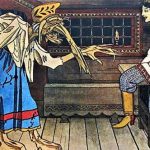 Weird Stuff
Weird Stuff  Weird Stuff
Weird Stuff  Politics
Politics 10 Political Scandals That Sent Crowds Into the Streets
 Weird Stuff
Weird Stuff Ten Bizarre Facts About The Doge Meme
 Our World
Our World 10 Ways Your Christmas Tree Is More Lit Than You Think
 Movies and TV
Movies and TV The 10 Coolest Stars to Set Sail on The Love Boat
 History
History 10 Things You Didn’t Know About the American National Anthem
 Technology
Technology Top 10 Everyday Tech Buzzwords That Hide a Darker Past
 Humans
Humans 10 Everyday Human Behaviors That Are Actually Survival Instincts
 Animals
Animals 10 Animals That Humiliated and Harmed Historical Leaders
 History
History 10 Most Influential Protests in Modern History
 Weird Stuff
Weird Stuff 10 Funny Ways That Researchers Overthink Christmas
 Politics
Politics 10 Political Scandals That Sent Crowds Into the Streets
 Weird Stuff
Weird Stuff Ten Bizarre Facts About The Doge Meme
Who's Behind Listverse?

Jamie Frater
Head Editor
Jamie founded Listverse due to an insatiable desire to share fascinating, obscure, and bizarre facts. He has been a guest speaker on numerous national radio and television stations and is a five time published author.
More About Us Our World
Our World 10 Ways Your Christmas Tree Is More Lit Than You Think
 Movies and TV
Movies and TV The 10 Coolest Stars to Set Sail on The Love Boat
 History
History 10 Things You Didn’t Know About the American National Anthem
 Technology
Technology Top 10 Everyday Tech Buzzwords That Hide a Darker Past
 Humans
Humans 10 Everyday Human Behaviors That Are Actually Survival Instincts
 Animals
Animals 10 Animals That Humiliated and Harmed Historical Leaders
 History
History 10 Most Influential Protests in Modern History
Ten Surreal Attempts to Reverse Baldness
Hair loss might not be a life-or-death issue, but it can have a major impact on people’s confidence. For that reason, we have spent centuries trying to find ways to cling to our gorgeous curls.
History has provided us with some wild remedy ideas, from pigeon droppings to buried mice jars. That said, some of our current theories are just as bizarre. Scientists have proposed all kinds of odd treatments, including synthetic wood smells, body sugars, and a chemical from McDonald’s fries. From outlandish past ideas to far-flung modern research, here are ten of the strangest ways people have tried to regrow their hair.
Related:Top 10 Debunked Historical Medical Treatments
10 McDonald’s Fries Ingredient
When you think of cutting-edge research into baldness, McDonald’s fries are probably not the first thing that comes to mind. Nonetheless, researchers in Japan say a cooking component for the starchy foodstuff could pave the way for a hair-loss cure.
The fast-food chain adds small amounts of a chemical called dimethylpolysiloxane to its oil to prevent it from foaming. A team at Yokohama National University found that the same substance can help regrow hair follicles on mice. They used the chemical to create thousands of tiny cells known as hair-follicle germs, which were then transplanted into bald rodents. The scientists were delighted to see that the scampering creatures grew fur once more.
Of course, the research does not stop there. Scientists hope that, through further studies, they can come up with a similar technique to help humans combat receding hairlines.[1]
9 Pigeon Poop
Hippocrates might be one of the most intelligent men who ever lived. The ancient Greek brainbox pioneered medicine as we know it today—but even geniuses make mistakes now and again.
As well as founding modern medicine, Hippocrates suffered from male-pattern baldness. So he came up with his own concoction to keep hair loss at bay. The physician mixed opium, horseradish, beetroot, spices, and, to top it all off, pigeon droppings. It will come as no surprise to our readers that his blend was completely useless for tackling baldness.
That said, one thing he did get correct was his observation that eunuchs never lost their locks. Many thousands of years later, a 1995 study from Duke University confirmed that the male hormone testosterone plays a crucial role in hair loss, validating Hippocrates’ observation if not his cure.[2]
8 Natural Body Sugar
Researchers in Britain and Pakistan have come up with a sweet new technique that they say could help restore hair growth—and when we say sweet, we mean literally sweet.
A team from the University of Sheffield and COMSATS University Islamabad has shown that a natural sugar, 2-deoxy-D-ribose (2dDR), could play a key role in restoring those luscious locks. 2dDR is found in the bodies of humans and many animals. The researchers discovered that sugar also stimulates hair regrowth in mice.
Scientists studying 2dDR as a wound-healing treatment noticed rapid hair growth around the treated areas. They then simulated male-pattern baldness in mice and found that the sugar boosted blood flow to the hair follicles. Thickets of hair began to spring up. The Sheffield-Islamabad team believes that deoxy ribose sugar could be as effective as drugs like Minoxidil at inspiring hair to grow again.[3]
7 Hemoglobin Capsules
The British have come up with some barmy ideas about science over the years, and hair loss is no exception. As recently as 100 years ago, people believed that hemoglobin—the protein found in red blood cells—was the cure for baldness that every thinning gentleman needed. Capsules soon hit the shelves that claimed to make hair “glossy, luxuriant, and full of vitality.”
Chemists claimed that iron in the blood could fight anemia and restore hair. The 1924 edition of Martindale’s Extra Pharmacopoeia even recommended hemoglobin and bone marrow as two ways to fend off baldness. The authors claimed that dandruff could be causing men to lose their locks. They encouraged thinning men to apply an amyl-nitrate solution to their heads.[4]
6 Create New Follicles
Imagine a hair-loss treatment that not only brings back your fading hair—it actively creates new follicles and leaves your fur thicker than before. Scientists in South Korea claim to have developed a new substance that could turn that idea into reality. It’s a complex, technical process, and studies are still in their early stages. However, results suggest that a drug for denser hair could be on its way.
Researchers at Yonsei University identified the protein responsible for male- and female-pattern baldness. This appears to be a regulator called CXXC5. They then developed a biomaterial that prevents CXXC5 from binding to other proteins in the Wnt pathway. This new substance, PTD-DBM, encourages hair to sprout again. Moreover, tests in mice show that the biomaterial can induce new follicles through a process known as wound-induced hair neogenesis. The team hopes their findings can be used to create a drug to treat hair loss—and maybe damaged tissue as well.[5]
5 Buried Mice
Mice seem to be a common theme when it comes to battling a receding hairline. Perhaps the strangest link between rodents and hair loss was made by the Irish over a thousand years ago. A bizarre Celtic remedy encouraged thinning men to cram mice into a clay jar, seal it, and then bury it next to a fire.
After a year, they had to retrieve the jar and remove everything from inside. Anyone tempted to try this method today should beware—make sure to wear gloves while digging the jar back up. If you touch it with your bare hands, the Celts warned, hair will spring up from your fingers.[6]
4 Hair Smells Sandalwood
For this next entry, we return to the world of modern science—although, to be honest, the newer “cures” can seem even stranger than historical ones made from crushed animals and bodily fluids.
In 2018, scientists announced that hair can sniff out odors and that the scent of artificial wood could stimulate regrowth. As you may know, our noses are full of olfactory receptors that govern our sense of smell. It turns out hair follicles contain olfactory receptors as well—including OR2AT4, the protein that picks up the scent of synthetic sandalwood.
A study of human scalp samples found that hair grows thicker after exposure to the man-made wood scent. Hair follicles essentially “smell” faux sandalwood via ancient chemical pathways. The scent then prompts increased hair growth and lower cell death.
“This is actually a rather amazing finding,” lead researcher Professor Ralf Paus told reporters. “This is the first time ever that it has been shown that the remodeling of a normal human mini-organ can be regulated by a simple, cosmetically widely used odorant.” [7]
3 Getting Licked by a Cow
Having a cow lick you on the head to treat hair loss might sound like the sort of crazed idea that people believed hundreds of years ago. However, as recently as the 1980s, balding men visited dairy farms in the hope that cattle slobbering on their scalps might restore their locks.
The story goes that in 1983, English farmer John Coombs received a lick on the head from his cow Primrose. Weeks later, Coombs and his wife were astonished to see his hair growing back after 25 years. He wrote to the media, and his story inspired West German hairdresser Eric Schmitt to try the same with some of his thinning customers.
Every week, a handful of German men would present their shiny tops to Liesel the cow, who would run her tongue along them for five minutes each. They paid $14 a session for the pleasure of Liesel’s saliva. After four months, just one of the men had regrown a few small wisps of peach fuzz. But the balding Germans continued to live in hope, coming back week after week for another session under Liesel’s tongue. One European firm even got in on the act, releasing its own hair-loss product called Likkit.[8]
2 Electric Hairbrush
The 1880s saw the arrival of Dr. Scott’s Electric Hairbrushes—a series of strange devices created by English entrepreneur George A. Scott. Mr. Scott marketed himself as a doctor, though there is no evidence that he had any medical training.
Despite the name, Scott’s tools did not run on electricity. Instead, they relied on magnetism and static charge. Each brush had several small iron rods fixed into its handle. When the user pulled the brush’s bristles through their hair or rubbed them against clothing, it sparked a static charge.
According to Mr. Scott, this static charge didn’t just treat hair loss; it could work miracles. He claimed his brushes “cured rheumatism, sciatica, gout, nervous debility, lumbago, neuralgia, toothache, malarial lameness, aches and pains from colds, impure blood, and impaired circulation,” among others. He brought out similar combs for horses, along with corsets, bracelets, and body belts. However, interest in Scott’s brushes was short-lived. By the 1890s, battery power was all the rage, and Scott’s devices were consigned to the history books.[9]
1 Egyptian Madness
The ancient Egyptians had no shortage of bizarre ideas for regrowing hair. Many of their strange treatments can be found in The Ebers Papyrus, one of the earliest known medical texts. The papyrus dates back to around 1550 BC and includes one entry that urges balding men to apply the fat of five animals to their scalps. The recipe uses fat from a lion, a hippo, a crocodile, a cat, and a serpent. The balm should then be slathered on the affected area.
Another remedy includes a mix of burned hedgehog spines in oil, fingernail scrapings, honey, alabaster, and red ocher. These need to be taken along with a magic chant to work properly.
The Egyptians took hair loss more seriously than you might think. A bald head was a sign of poor morals and servitude. Many wore wigs to hide their shiny tops. Occasionally, though, the pendulum of fashion swung the other way. At times, the hairless look was in vogue, and Egyptians deliberately shaved their heads as a sign of rank or religion.
So, to any worried readers going thin on top, try not to stress. Hopefully, one day fashion will shift again, as it did in ancient Egypt, and your hairless heads will be revered once more.[10]








